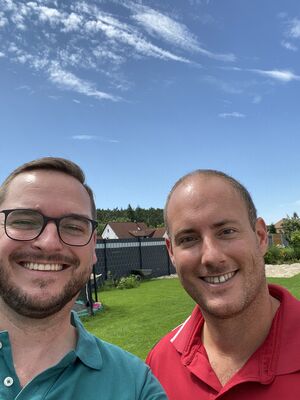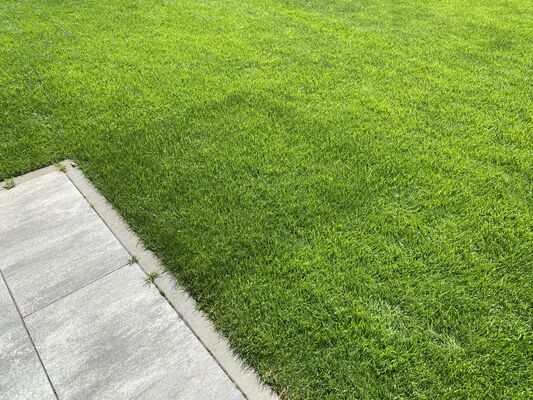Dark Green Secrets of a Resilient Lawn

Dark Green Secrets of a Resilient Lawn
An Interview with a lawn care professional deep down in southern Germany

Robust lawns with PerlHumus, Humiron and HS-300 Bio. Marco Hahn has been a PerlHumus fan from the very beginning, but last fall he was given the chance to test some of our other products and today he talks about the results with product manager Jan Mühlena.
JM: Let's start with your lawn. How big is the area and when did you install it?
MH: We built the house in 2015 and moved in in 2016, so this lawn has been there for 5 years now.
JM: And what kind of soil do you have here?
MH: Pure humus, 15 cm mounded. Compost humus here from the area. That was about 5 truckloads full. I haven't regretted it. In the beginning, of course, you have some weeds, sure, but that settles down.
JM: Okay, so you have a very high humic content there anyway.
MH: Yeah, nice black soil. The subsoil is very rocky, so maybe they'll come up eventually. But right now I'm happy. Tilled there yesterday and went through like butter.
JM: Have you had any subsidence problems?
MH: Very slight dents, but maybe even from the initial applying of the soil.
JM: You've been using PerlHumus since the beginning. Is it a disadvantage for you that PerlHumus just sits as granules first and works itself into the soil?
MH: I think it's good, because it dissolves properly over time and I get something out of it permanently. If I throw something on it once every six to eight weeks, then you have little black dots there from time to time… and then there's a new supply.
JM: How often do you put it on and how much?
MH: Every 2 months, about 5 kg per 100 square meters, so for me it's about 20 kg per 400 square meters, a whole bag.
JM: Have you ever stuck a spade in and seen what it looks like at that point?
MH: Yes. I also posted on Instagram last year, where I also dug up a square. I really had roots that were 25 centimeters long. This year is different, because of the cold May, you can see that clearly now in June. If there's no rain for three days, it immediately cries out for water.
JM: Sure. Do you think with the use of PerlHumus this tendency is a bit less? That you don't have to water as much?
MH: I would normally say that, yes. Absolutely. But this year it's difficult. I did that last year, too, and there was only PerlHumus on it and I had super long roots. I was the only one here who watered briefly once a week in the morning, while everyone else had to water for an hour every day in the evening. I also have a moisture sensor in the soil.

JM: Okay, what does that tell us? Is that a tensiometer?
MH: Yes. It measures soil moisture by electrical conductivity, the TDR probe. Now it rained a lot yesterday and we have 70% soil moisture at 20 cm depth. And I know it for my lawn, if I get below the value of forty-five, then it becomes slightly bluish on top and stays. Then I definitely know, now it needs proper water again.
JM: Okay, on to the hard facts: What varieties do you use?
MH: It's a mixture of Lolium perenne, Poa pratensis and Poa supina. I'm very happy with it. I also use the mixture with customers. It's very heat resistant, but you can also play on it. You can mow it short. I just don't like it, keep it mostly between 18 and 23 millimeters, I like it better for the little guy too. What's also clearly good for the lawn is using a reel mower.
JM: Sure. Do you aerate as well?
MH: Yes, twice a year. Then I put PerlHumus, fertilizer and sand in the holes. I apply that one after the other and then go over it with the rake. I do the same at my customer’s, I aerate at least once a year, that's the standard program. At the beginning of the year is the new plantings and in the fall and spring, the main maintenance. With my results over spring, customers insisted I come back in September.
JM: Very nice. Last year you put Humiron on your own lawn and did the test. We were pleased that the results were so good.
MH: You have to turn around! You can still see the square. I left it extra so you could see it and haven't reworked it yet. I had tried five test plots and the best combination was HS-300 Bio, Patent Kali and Wolf fall fertilizer. That was the holy grail, so to speak.
JM: Yeah, right! That's humiron? That's really awesome. I'll have to take a picture of that. You can really see it. There's really this sharp, dark green square. It's amazing! How much did you put on it?
MH: A five percent solution.
JM: And you also had experience with our liquid PerlHumus, the HS-300 Bio. How did you like it?
MH: Yeah, it was pretty cool to spray on; because of the brown color when you apply it, you can see where you've already sprayed, where too much, where it's missing – with the electric pump sprayer it's also super nice to spread. I have a sprayer, battery-operated with a capacity of 6 liters, and I put a five-percent solution in it. After 10 or 20 square meters, I had problems with a clogged plastic sieve in the container, but after I removed it, it worked perfectly. And the humic substances support the fertilization, the lawn can simply absorb the nutrients better, you notice that.
JM: If you were to compare PerlHumus and HS 300 now? What would you say?
MH: For the immediate result, HS-300 has been mega nice. But because of the easier application, the granules are better for the regular user – very few people have a syringe like that.
JM: What do you want for 2022? What are you planning to do? What products do you want to use?
MH: Well, the mixture I have now, I'm very happy with it. I will not differ from the PerlHumus and my fertilizers. And, of course, I'm going to use Humiron everywhere, so it looks consistent.
Thank you for the interview!
Lawn helper Marco Hahn is online at www.rasenhelfer.de and on Instagram and Facebook.


Comments
No Comments